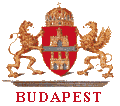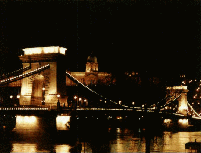

A Tiny Tour of Budapest
 |
The Danube bank in Budapest is one of the loveliest town centers in Europe. Visible in this picture are the Parliament, to the right, and the Széchenyi Lánchíd, or Chainbridge. Buda, to the left, is hilly and picturesque. Pest, to the right, a separate city until the second half of the 19th century, is flat, stately and quaint (not to mention a bit polluted). Click to enlarge. |
 |
The Széchenyi Lánchíd, or Chainbridge, was built by István Szécheny in the second half of the 19th century. It was the first bridge to link Buda and Pest. It was thus that the new city, Budapest was created. The Bridge recently won an award as the second most beautiful bridge in the world.Click for more, bigger pics of the beautiful bridge. |
 |
A typical sidestreet in Budapest, showing the baroque architecture common in the city. Click to enlarge. |
 |
Beauty can be tucked away in the corners, waiting to surprise you, as in this typical Budapest stairwell. Click to enlarge. |
 |
No modern European city would be complete without its own subway system, or Metro. Click for Metro map of Budapest: |

Here's a medieval artist's rendering of Buda. Note the castle wall, still visible in some places today. The city dates back to Roman times.
| Tips for a stroll around town |
|
It's worth walking over the Chain Bridge because of the view. It only takes a few minutes, because the Danube isn't all that wide. The approaches to the bridge are slightly busy, of course. First you could visit Vörösmarty Square (Vörösmarty tér), at the end of the yellow line or the subway/underground (called kis földalatti in Hungarian). It's a nice place, and you could walk up and down Vörösmarty utca (street), a well-preserved pedestrian zone and shopping district. It's also easy to get to Vigadó tér on foot from Vörösmarty Square. The view is lovely there, and you can get the No. 2 tram/streetcar to the Chain Bridge. It's also where you should catch a bout to take you on a two-hour cruise of the Danube up and down Budapest, preferably at seven p.m., when the bridges and buildings will be illuminated when you are on your way back. After crossing the Chain Bridge, you would find yourself at Clark Adam tér. This is where you can catch a ski lift up to the Buda Castle (Budavár), more of a palace than a castle really, which contains the National Gallery. Once you are up there, walk all along Castle Hill (Várhegy), with it's lovely Medieval buildings. All the restaurants here are expensive. Another bridge worth walking on is the Margit (that's Margaret) Bridge, not because the bridge is lovely but because of the view from the middle of the bridge, where there is a sort of observation deck, and because that's where Margaret Island (Margit Sziget) is, with it's lovely park for walking and having picnics in. Take the no. 4 or 6 tram/streetcar to the middle of the bridge. Parliament can be visited at Kossuth tér, easily accessible on the red underground-subway line. It's impressive. Heroes' Square (Hősök tere) is worth a look, also on the yellow line, as is the Opera. See a ballet at the opera; it's lovely inside. We just saw Swan Lake, which was just amazing. Another lovely building is the Iparművészeti Múzeum (this is like the museum of crafts or something). Worth a stop, and not far from the 4 and 6 tram/streetcar lines. Cruises can be taken to other great places nearby: Szentendre, Visegrad and Esztergom. I heartliy recommend taking just a circular route, setting out to the north in the evening, and swinging back in the dark. Seeing the banks of the Danube from a boat at night, with all the illuminated monuments and bridges drifting by and towering over your head, is well worth it. Enjoy your trip to Budapest! |
| Entertainment in Budapest |
|
Movies: Newspapers and magazines: Theater: |
| Practical info |
|
[Language learning resources]
[Star Trek]
[Golden student bloopers]
[Shop]
[Hungary]
[Music]
[Magyarnyelvű honlap: Hungarian homepage]
[Home]

